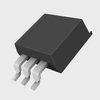Part Details for STB55NF06L by STMicroelectronics
Results Overview of STB55NF06L by STMicroelectronics
- Distributor Offerings: (0 listings)
- Number of FFF Equivalents: (0 replacements)
- CAD Models: (Request Part)
- Number of Functional Equivalents: (0 options)
- Part Data Attributes: (Available)
- Reference Designs: (Not Available)
Tip: Data for a part may vary between manufacturers. You can filter for manufacturers on the top of the page next to the part image and part number.
STB55NF06L Information
STB55NF06L by STMicroelectronics is a Power Field-Effect Transistor.
Power Field-Effect Transistors are under the broader part category of Transistors.
A transistor is a small semiconductor device used to amplify, control, or create electrical signals. When selecting a transistor, factors such as voltage, current rating, gain, and power dissipation must be considered, with common types. Read more about Transistors on our Transistors part category page.
Part Details for STB55NF06L
STB55NF06L CAD Models
STB55NF06L Part Data Attributes
|
|
STB55NF06L
STMicroelectronics
Buy Now
Datasheet
|
Compare Parts:
STB55NF06L
STMicroelectronics
N-channel 60 V, 0.014 Ohm typ., 35 A StripFET II Power MOSFET in a D2PAK package
|
| Rohs Code | Yes | |
| Part Life Cycle Code | Active | |
| Ihs Manufacturer | STMICROELECTRONICS | |
| Part Package Code | D2PAK | |
| Package Description | SMALL OUTLINE, R-PSSO-G2 | |
| Pin Count | 3 | |
| Reach Compliance Code | not_compliant | |
| ECCN Code | EAR99 | |
| Samacsys Manufacturer | STMicroelectronics | |
| Avalanche Energy Rating (Eas) | 300 mJ | |
| Case Connection | DRAIN | |
| Configuration | SINGLE WITH BUILT-IN DIODE | |
| DS Breakdown Voltage-Min | 60 V | |
| Drain Current-Max (ID) | 55 A | |
| Drain-source On Resistance-Max | 0.02 Ω | |
| FET Technology | METAL-OXIDE SEMICONDUCTOR | |
| JEDEC-95 Code | TO-263AB | |
| JESD-30 Code | R-PSSO-G2 | |
| JESD-609 Code | e3 | |
| Number of Elements | 1 | |
| Number of Terminals | 2 | |
| Operating Mode | ENHANCEMENT MODE | |
| Operating Temperature-Max | 175 °C | |
| Package Body Material | PLASTIC/EPOXY | |
| Package Shape | RECTANGULAR | |
| Package Style | SMALL OUTLINE | |
| Polarity/Channel Type | N-CHANNEL | |
| Power Dissipation-Max (Abs) | 95 W | |
| Pulsed Drain Current-Max (IDM) | 220 A | |
| Qualification Status | Not Qualified | |
| Surface Mount | YES | |
| Terminal Finish | MATTE TIN | |
| Terminal Form | GULL WING | |
| Terminal Position | SINGLE | |
| Transistor Application | SWITCHING | |
| Transistor Element Material | SILICON |
STB55NF06L Frequently Asked Questions (FAQ)
-
The maximum junction temperature (Tj) for the STB55NF06L is 150°C. However, it's recommended to keep the junction temperature below 125°C for reliable operation and to ensure the device's lifespan.
-
To calculate the power dissipation of the STB55NF06L, you need to consider the voltage drop across the device (Vds) and the current flowing through it (Ids). The power dissipation (Pd) can be calculated using the formula: Pd = Vds x Ids. Additionally, you should also consider the thermal resistance (Rth) of the device and the ambient temperature (Ta) to ensure the device operates within its thermal limits.
-
To minimize EMI and thermal issues, it's recommended to follow a good PCB layout practice for the STB55NF06L. This includes keeping the power traces short and wide, using a solid ground plane, and placing the device close to the heat sink or thermal pad. Additionally, it's recommended to use a Kelvin connection for the source pin to reduce the parasitic inductance and improve the device's performance.
-
Yes, the STB55NF06L is suitable for high-frequency switching applications up to 100 kHz. However, it's essential to consider the device's switching characteristics, such as the rise and fall times, and ensure that the device is properly driven to minimize switching losses and EMI.
-
To protect the STB55NF06L from overvoltage and overcurrent conditions, it's recommended to use a voltage regulator or a voltage clamp to limit the voltage across the device. Additionally, you can use a current sense resistor and a comparator to detect overcurrent conditions and shut down the device if necessary. It's also essential to follow the recommended operating conditions and guidelines provided in the datasheet.
